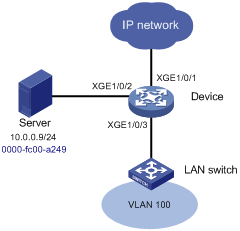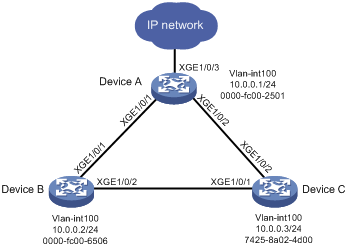- Table of Contents
-
- H3C Fixed Port Campus Switches Configuration Examples-B70D029-6W100
- 01-Login Management Configuration Examples
- 02-RBAC Configuration Examples
- 03-Software Upgrade Examples
- 04-ISSU Configuration Examples
- 05-Software Patching Examples
- 06-Ethernet Link Aggregation Configuration Examples
- 07-Port Isolation Configuration Examples
- 08-Spanning Tree Configuration Examples
- 09-VLAN Configuration Examples
- 10-VLAN Tagging Configuration Examples
- 11-DHCP Snooping Configuration Examples
- 12-Cross-Subnet Dynamic IP Address Allocation Configuration Examples
- 13-IPv6 over IPv4 Tunneling with OSPFv3 Configuration Examples
- 14-IPv6 over IPv4 GRE Tunnel Configuration Examples
- 15-GRE with OSPF Configuration Examples
- 16-OSPF Configuration Examples
- 17-IS-IS Configuration Examples
- 18-BGP Configuration Examples
- 19-Policy-Based Routing Configuration Examples
- 20-OSPFv3 Configuration Examples
- 21-IPv6 IS-IS Configuration Examples
- 22-Routing Policy Configuration Examples
- 23-IGMP Snooping Configuration Examples
- 24-IGMP Configuration Examples
- 25-MLD Snooping Configuration Examples
- 26-IPv6 Multicast VLAN Configuration Examples
- 27-ACL Configuration Examples
- 28-Traffic Policing Configuration Examples
- 29-GTS and Rate Limiting Configuration Examples
- 30-Priority Mapping and Queue Scheduling Configuration Examples
- 31-Traffic Filtering Configuration Examples
- 32-AAA Configuration Examples
- 33-Port Security Configuration Examples
- 34-Portal Configuration Examples
- 35-SSH Configuration Examples
- 36-IP Source Guard Configuration Examples
- 37-Ethernet OAM Configuration Examples
- 38-CFD Configuration Examples
- 39-DLDP Configuration Examples
- 40-VRRP Configuration Examples
- 41-BFD Configuration Examples
- 42-NTP Configuration Examples
- 43-SNMP Configuration Examples
- 44-NQA Configuration Examples
- 45-Mirroring Configuration Examples
- 46-sFlow Configuration Examples
- 47-OpenFlow Configuration Examples
- 48-MAC Address Table Configuration Examples
- 49-Static Multicast MAC Address Entry Configuration Examples
- 50-IP Unnumbered Configuration Examples
- 51-MVRP Configuration Examples
- 52-MCE Configuration Examples
- 53-Attack Protection Configuration Examples
- 54-Smart Link Configuration Examples
- 55-RRPP Configuration Examples
- 56-BGP Route Selection Configuration Examples
- 57-IS-IS Route Summarization Configuration Examples
- 58-IRF Configuration Examples
- 59-VXLAN Configuration Examples
- Related Documents
-
| Title | Size | Download |
|---|---|---|
| 48-MAC Address Table Configuration Examples | 101.74 KB |
Example: Configuring static MAC address entries
Applicable hardware and software versions
Example: Configuring MAC address move suppression
Applicable hardware and software versions
Configuring Device B and Device C
Introduction
This document provides MAC address table configuration examples.
Prerequisites
The configuration examples in this document were created and verified in a lab environment, and all the devices were started with the factory default configuration. When you are working on a live network, make sure you understand the potential impact of every command on your network.
This document assumes that you have basic knowledge of the MAC address table.
Example: Configuring static MAC address entries
Network configuration
As shown in Figure 1, for secure communication between users in VLAN 100 and the server, perform the following tasks:
· Assign Ten-GigabitEthernet 1/0/2 and Ten-GigabitEthernet 1/0/3 to VLAN 100.
· Add a static MAC address entry on Device to bind the server MAC address to Ten-GigabitEthernet 1/0/2.

Applicable hardware and software versions
The following matrix shows the hardware and software versions to which this configuration example is applicable:
|
Hardware |
Software version |
|
S6520X-HI switch series S6520X-EI switch series |
Supported in Release 1110P01 |
|
S6520X-SI switch series S6520-SI switch series S5000-EI switch series MS4600 switch series |
Supported in Release 1110P01 |
Procedures
# Create VLAN 100, and assign Ten-GigabitEthernet 1/0/2 to VLAN 100.
<Device> system-view
[Device] vlan 100
[Device-vlan100] quit
[Device] interface ten-gigabitethernet 1/0/2
[Device-Ten-GigabitEthernet1/0/2] port link-mode bridge
[Device-Ten-GigabitEthernet1/0/2] port access vlan 100
[Device-Ten-GigabitEthernet1/0/2] undo shutdown
[Device-Ten-GigabitEthernet1/0/2] quit
# Configure Ten-GigabitEthernet 1/0/3 (port connected to the LAN switch) as a trunk port, and assign the port to VLAN 100.
[Device] interface ten-gigabitethernet 1/0/3
[Device-Ten-GigabitEthernet1/0/3] port link-mode bridge
[Device-Ten-GigabitEthernet1/0/3] port link-type trunk
[Device-Ten-GigabitEthernet1/0/3] port trunk permit vlan 100
[Device-Ten-GigabitEthernet1/0/3] undo shutdown
[Device-Ten-GigabitEthernet1/0/3] quit
# Add a static entry for MAC address 0000-fc00-a249 on Ten-GigabitEthernet 1/0/2 that belongs to VLAN 100.
[Device] mac-address static 0000-fc00-a249 interface ten-gigabitethernet 1/0/2 vlan 100
Verifying the configuration
# Verify that any 10.0.0.0/24 host in VLAN 100 can communicate with the server. (Details not shown.)
# Verify that the static MAC address entry has been added.
[Device] display mac-address
MAC Address VLAN ID State Port/NickName Aging
0000-fc00-a249 100 Static XGE1/0/2 N
7425-8a02-4d00 100 Learned XGE1/0/3 Y
…
Configuration files
#
sysname Device
#
vlan 1
#
vlan 100
#
interface Ten-GigabitEthernet1/0/2
port link-mode bridge
port access vlan 100
mac-address static 0000-fc00-a249 vlan 100
#
interface Ten-GigabitEthernet1/0/3
port link-mode bridge
port link-type trunk
port trunk permit vlan 1 100
#
Example: Configuring MAC address move suppression
Network configuration
As shown in Figure 2, Devices A, B, and C form a loop because of cable misconnection, and spanning tree protocols are not enabled on the devices. As a result, MAC addresses are frequently moves among Devices A, B, and C. To deal with loop-triggered MAC flapping, perform the following tasks:
· Display MAC address move records to locate the Layer 2 loop.
· Configure MAC address move suppression on Device A to eliminate the Layer 2 loop.

Analysis
To meet the network requirements, you must perform the following tasks:
· For Devices A, B, and C to communicate with each other, assign all inter-connected ports to VLAN 100.
· Configure MAC address move suppression on one or more ports of Device A.
· To monitor the port status change of Device A, enable the log monitoring of the current terminal feature.
· For loop detection, create VLAN-interface 100 and assign an IP address to the interface on each device.
· To display MAC address move records, ping Device B from Device A.
Applicable hardware and software versions
The following matrix shows the hardware and software versions to which this configuration example is applicable:
|
Hardware |
Software version |
|
S6520X-HI switch series S6520X-EI switch series |
Supported in Release 1110P01 |
|
S6520X-SI switch series S6520-SI switch series S5000-EI switch series MS4600 switch series |
Supported in Release 1110P01 |
Procedures
Configuring Device A
# Enable the monitoring of logs on the current terminal.
<DeviceA> terminal monitor
<DeviceA> terminal debugging
# Create VLAN 100.
<DeviceA> system-view
[DeviceA] vlan 100
[DeviceA-vlan100] quit
# Configure Ten-GigabitEthernet 1/0/1 and Ten-GigabitEthernet 1/0/2 as trunk ports, and assign the ports to VLAN 100.
[DeviceA] interface range ten-gigabitethernet 1/0/1 ten-gigabitethernet 1/0/2
[DeviceA-if-range] port link-mode bridge
[DeviceA-if-range] port link-type trunk
[DeviceA-if-range] port trunk permit vlan 100
[DeviceA-if-range] undo shutdown
[DeviceA-if-range] quit
# Set the suppression interval to 300 seconds. A suppressed port will automatically come up after 300 seconds.
[DeviceA] mac-address notification mac-move suppression interval 300
# Set the suppression threshold to 0. A port will be shut down when the system detects a MAC address move on the port within a MAC move detection interval (1 minute by default).
[DeviceA] mac-address notification mac-move suppression threshold 0
# Enable MAC address move suppression on Ten-GigabitEthernet 1/0/1.
[DeviceA] interface ten-gigabitethernet 1/0/1
[DeviceA-Ten-GigabitEthernet1/0/1] mac-address notification mac-move suppression
[DeviceA-Ten-GigabitEthernet1/0/1] quit
# Create VLAN-interface 100, and assign an IP address to the interface.
[DeviceA] interface vlan-interface 100
[DeviceA-Vlan-interface100] ip address 10.0.0.1 24
[DeviceA-Vlan-interface100] quit
Configuring Device B and Device C
1. Configure Device B:
# Create VLAN 100.
<DeviceB> system-view
[DeviceB] vlan 100
[DeviceB-vlan100] quit
# Configure Ten-GigabitEthernet 1/0/1 and Ten-GigabitEthernet 1/0/2 as trunk ports, and assign the ports to VLAN 100.
[DeviceB] interface range ten-gigabitethernet 1/0/1 ten-gigabitethernet 1/0/2
[DeviceB-if-range] port link-mode bridge
[DeviceB-if-range] port link-type trunk
[DeviceB-if-range] port trunk permit vlan 100
[DeviceB-if-range] undo shutdown
[DeviceB-if-range] quit
# Create VLAN-interface 100, and assign an IP address to the interface.
[DeviceB] interface vlan-interface 100
[DeviceB-Vlan-interface100] ip address 10.0.0.2 24
[DeviceB-Vlan-interface100] quit
2. Configure Device C in the same way Device B was configured. (Details not shown.)
Verifying the configuration
# Ping Device B from Device A. (Details not shown.)
# Verify that Ten-GigabitEthernet 1/0/1 on Device A is shut down.
[DeviceA] %Dec 11 09:51:06:309 2016 DeviceA IFNET/3/PHY_UPDOWN: -MDC=1; Physical state on the Ten-GigabitEthernet1/0/1 changed to down.
%Dec 11 09:51:06:323 2016 DeviceA IFNET/5/LINK_UPDOWN: -MDC=1; Line protocol state on
the interface Ten-GigabitEthernet1/0/1 changed to down.
# Verify that Ten-GigabitEthernet 1/0/1 is shut down because a MAC address move is detected.
[DeviceA] display interface ten-gigabitethernet 1/0/1
Ten-GigabitEthernet1/0/1
Current state: mac-address moving down
Line protocol state: DOWN
...
# Verify that Ten-GigabitEthernet 1/0/1 comes up automatically after 300 seconds.
[DeviceA] %Dec 11 09:56:07:002 2016 DeviceA IFNET/3/PHY_UPDOWN: -MDC=1; Physical state on the Ten-GigabitEthernet1/0/1 changed to up.
%Dec 11 09:56:07:004 2016 DeviceA IFNET/5/LINK_UPDOWN: -MDC=1; Line protocol state on
the interface Ten-GigabitEthernet1/0/1 changed to up.
# Verify that the MAC address of Device B's VLAN-interface 100 moves between Ten-GigabitEthernet 1/0/1 and Ten-GigabitEthernet 1/0/2. You can manually shut down either port to eliminate the loop.
[DeviceA] display mac-address mac-move
MAC address VLAN Current port Source port Last time Times
0000-fc00-6506 100 XGE1/0/2 XGE1/0/1 2014-12-11 09:29:48 3
0000-fc00-6506 100 XGE1/0/1 XGE1/0/2 2014-12-11 09:51:03 4
--- 2 MAC address moving records found ---
Configuration files
· Device A:
#
sysname DeviceA
#
mac-address notification mac-move suppression interval 300
mac-address notification mac-move suppression threshold 0
#
vlan 1
#
vlan 100
#
interface Vlan-interface100
ip address 10.0.0.1 255.255.255.0
#
interface Ten-GigabitEthernet1/0/1
port link-mode bridge
port link-type trunk
port trunk permit vlan 1 100
mac-address notification mac-move suppression
#
interface Ten-GigabitEthernet1/0/2
port link-mode bridge
port link-type trunk
port trunk permit vlan 1 100
#
· Device B:
#
sysname DeviceB
#
vlan 1
#
vlan 100
#
interface Vlan-interface100
ip address 10.0.0.2 255.255.255.0
#
interface Ten-GigabitEthernet1/0/1
port link-mode bridge
port link-type trunk
port trunk permit vlan 1 100
#
interface Ten-GigabitEthernet1/0/2
port link-mode bridge
port link-type trunk
port trunk permit vlan 1 100
#
· Device C:
#
sysname DeviceC
#
vlan 1
#
vlan 100
#
interface Vlan-interface100
ip address 10.0.0.3 255.255.255.0
#
interface Ten-GigabitEthernet1/0/1
port link-mode bridge
port link-type trunk
port trunk permit vlan 1 100
#
interface Ten-GigabitEthernet1/0/2
port link-mode bridge
port link-type trunk
port trunk permit vlan 1 100

